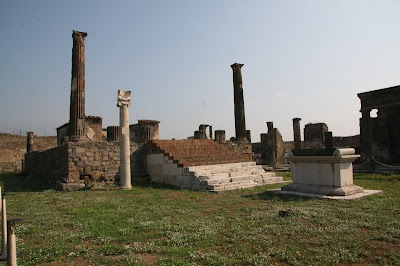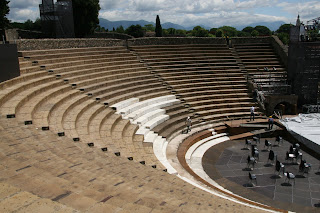
Unknown, Apollo as an Archer (The Apollo Saettante), 100 BC- AD79. Medium: Bronze. Dimensions: Object: H: 147 x W: 55 x D: 114 cm (57 7/8 x 21 5/8 x 44 7/8 in.) Accession No. VEX.2011.1.1 Soprintendenza Speciale per i Beni Archeologici di Napoli e Pompei, Naples, Italy, 5629.
LOS ANGELES, CA (AP).- After eighteen months of analysis, conservation, and re-stabilization, the bronze statue of Apollo Saettante (Apollo as an Archer) from Pompeii will go on view at the Getty Villa from March 2 to September 12, 2011 in the exhibition Apollo from Pompeii: Investigating an Ancient Bronze. Providing a behind-the-scenes look at this rare treasure, the special six-month exhibition presents the results of the first full study of this ancient sculpture.
Originally located in the Temple of Apollo in Pompeii, the Apollo Saettante was discovered in fragments centuries after it was buried by the eruption of Mt. Vesuvius in AD 79. The bulk of the figure was unearthed in June 1817 just north of the Forum. A year later, in October 1818, veteran soldiers hunting a fox near the ancient city walls stumbled across some of the statue’s still-missing parts. The Apollo was one of the first major bronzes to be found at Pompeii, and was subsequently reassembled and displayed in the Real Museo Borbonico in Naples.
The conservation of the Apollo Saettante at the Getty Villa is the result of an important collaboration between the J. Paul Getty Museum and the Museo Archeologico Nazionale in Naples, as part of a broad cultural exchange agreement made in 2007 between the Italian Ministry of Culture and the Getty Museum. This exhibition marks the Apollo Saettante’s first showing in the United States, and complements the Villa’s collection of ancient works from Greece, Rome, and Etruria. Following its exhibition in Los Angeles, the statue will be returned to Naples, where the Getty's conservation efforts will ensure its stability for generations.
The Apollo Saettante arrived in Los Angeles on loan for study and conservation treatment in 2009, together with the Statue of an Ephebe (Youth) as a Lampbearer, which is currently on view in the Basilica at the Getty Villa.
“This project has provided us an unprecedented opportunity,” said Erik Risser, an assistant conservator of antiquities at the J. Paul Getty Museum and co-curator of the exhibition. “Large bronzes rarely survive from antiquity, and the chance to conduct a thorough investigation into the Apollo Saettante has brought to light its rich and complex history.”
A variety of approaches, including archival research, X-radiography, ultra-violet photography, and endoscopic examination, have provided important new information regarding both the techniques used to make the statue in antiquity, and also the methods used to restore it in the nineteenth century. The investigations extended to analyses of the metal alloy composition, the pigments on the surface, and even of the types of bolts used in the re-assembly, all to answer questions about previous restoration efforts.
Apollo from Pompeii: Investigating an Ancient Bronze presents the results of these investigations, displaying art-historical, technical, and scientific evidence side by side in order to demonstrate the range of methods used during the study of the statue at the Getty Villa. Special features include the discovery of a large void in the statue’s back, which indicates that the method of its ancient manufacture was highly unusual, and the identification of two different phases of restoration. An interactive touch-screen display in the exhibition will provide visitors with the opportunity to explore the statue. This interactive feature will also be available on the Web at www.getty.edu.
Alongside select examples of ancient bronze sculpture from the Getty Museum’s Antiquities collection and a series of archival drawings and documents from the Getty Research Institute, the exhibition will also feature a bronze statue of Artemis, the sister piece to the Apollo Saettante. The two faced one another in the Temple of Apollo at Pompeii, and the inclusion of the Artemis, also on loan from the Museo Archeologico Nazionale in Naples, will provide a unique opportunity to develop and extend the discoveries that have been made in examining the Apollo.
This exhibition follows a series of Getty Villa exhibitions devoted to restoration and conservation, including The Hope Hygeia: Restoring a Statue’s History (2008), Fragment to Vase: Approaches to Ceramic Restoration (2008-2009), and Reconstructing Identity: A Statue of a God from Dresden (2009-2010), as well as early excavations in the Bay of Naples (The Herculaneum Women and the Origins of Archeology, 2007).
The exhibition is also one in a series of Italian collaborations that have brought important works of art to the Getty Museum, beginning in June 2009 with the display of the Chimaera of Arezzo in partnership with the Museo Archeologico Nazionale in Florence. The Getty also has long-term agreements with the Museo Archeologico Nazionale in Naples, and the Sicilian Ministry of Culture and Sicilian Identity, for exhibitions over the coming years.























